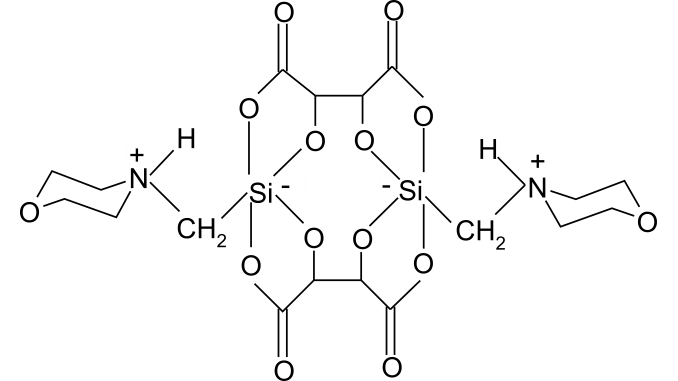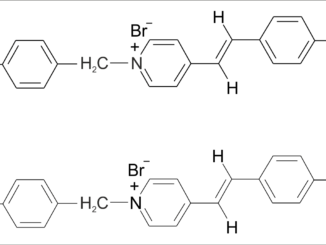
Paper category: Original research paper
Corresponding author: Mariusz Kluska (kluskam@uph.edu.pl)
DOI: 10.1515/ohs-2020-0022
Received: 21/02/2020
Accepted: 09/04/2020
Full text: here
Citation (APA style): Oceanological and Hydrobiological Studies, Volume 49, Issue 3, Pages 247–254, eISSN 1897-3191, ISSN 1730-413X, DOI: https://doi.org/10.1515/ohs-2020-0022.
Abstract
The analyzed organosilicon derivatives of electrostatically stabilized silanates belong to a group of pentacoordinated compounds. These derivatives are:1-(N-morpholiniomethyl)spirobi(1-sila-2,5-dioxacyclopentan-3-on)at,1-(N-morpholiniomethyl)spirobi(1-sila-2,5-dioxa-4-methylcyclopentan-3-on)at,1-(N-morpholiniomethyl)spirobi(1-sila-2,5-dioxa-4-(i-propyl)cyclopentan-3-on)at.
In the course of the work, the extraction process and optimization of conditions for separation and determination of a mixture of electrostatically stabilized silanates were carried out using capillary isotachophoresis. Proper leading electrolytes were elaborated developed and the terminating electrolyte:4,4’-bis[(1-morpholiniomethyl)spirobi(1-sila-2,5-dioxacyclopentan-3-on)at] was proposed. The extraction process involved the use of three stationary phases: octadecyl, octyl and phenylpropyl. The highest recovery values, approx. 94%, were obtained on the phenylpropyl column. The optimum time of analysis by the isotachophoretic technique did not exceed 12 min. The developed method of separation and determination of electrostatically stabilized silanates expands the possibility of research on biological activity of this group of compounds in aqueous solutions and surface water vegetation.
References
Böhme, U., Wiesner, S. & Günther, B. (2006). Easy access to chiral penta-and hexacoordinate silicon compounds. Inorg. Chem. Comm. 9(8): 806–809. DOI: 10.1016/j.inoche.2006.05.002.
Buszewski, B. & Szultka, M. (2012). Past, present, and future of solid phase extraction: A review. Crit. Rev. Anal. Chem. 42(3): 198–213. DOI: 10.1080/07373937.2011.645413.
Durka, K., Laudy, A.E., Charzewski, Ł., Urban, M., Stępień, K. et al. (2019). Antimicrobial and KPC/AmpC inhibitory activity of functionalized benzoiloxaboroles. Eur. J. Med. Chem. 171: 11–24. DOI: 10.1016/j.ejmech.2019.03.028
Erchak, N., Lukjanchik, I.D., Koval, T. & Andrijak, O.O. (2005). Stimulator rosta rostienij, Patent 7079 Republic of Belarus, National Centre of Intellectual Property. Off. Biull. 2: 114–118.
Erchak, N., Olszewska, E., Kalvinish, I., Liepinsh, E., Belyakov, S. et al. (2015). Synthesis of pentacoordinated Si-(morpholiniomethyl)silanates. Chem. Heterocycl. Comp. 50: 1505–1508. DOI: 10.1007/s10593-014-1617-x.
Gadzała-Kopciuch, R., Kluska, M., Wełniak, M. & Buszewski, B. (2005). Silicon dioxide surfaces with aryl interaction sits for chromatographic applications. Mater. Chem. Phys. 89(2–3):228–237. DOI: 10.1016/j.matchemphys.2004.03.022.
Guo-Chao, Y., Nikolic, M., Mu-jun, Y., Zhuo-xi, X. & Yong-Chao, L. (2018). Silicon acquisition and accumulation in plant and its significance for agriculture. J. Integr. Agr. 17(10): 2138–2150. DOI: 10.1016/S2095-3119(18)62037-4.
Hu, Y., Wanh, Y., Li, F., Ma, C. & Wang, J. (2017). Design and expeditious synthesis of organosilanes as potent antivirals targeting multidrug-resistant influenza A viruses. Eur. J. Med. Chem. 135: 70–76. DOI: 10.1016/j.ejmech.2017.04.038.
Jabłońska, J., Kluska, M. & Erchak, N. (2018). Analytics of biologically active derivatives of electrostatically stabilized by isotachophoresis. J. Liq. Chromatogr. Rel. Technol. 41(19–20): 1098–1103. DOI: 10.1080/10826076.2019.1566139.
Kenla, T.J., Tatong, M.D., Talontsi, F.M., Dittrich, B., Frauendorf, H. et al. (2013). Si-enterobactin from the endophytic Streptomyces sp. KT-S1-B5-a potential silicon transporter in nature? Chem. Commun. 49: 7641–7643. DOI: 10.1039/C3CC44437F.
Kluska, M. (2008a). Analytical techniques in determination of biologically active organosilicons of the ES-silanate group. Crit. Rev. Anal. Chem. 38(4): 216–226. DOI: 10.1080/10408340802341096.
Kluska, M. (2008b). Some aspects of the analysis of biologically active organogermanium substances. Crit. Rev. Anal. Chem. 38(2): 84–92. DOI: 10.1080/10408340701804459.
Kluska, M., Jabłońska, J. & Erchak, N. (2019a). Analytics and application of biologically active pentacoordinate electrostatically stabilized silanates. Crit. Rev. Anal. Chem. DOI: 10.1080/10408347.2019.1666249.
Kluska, M., Jabłońska, J., Prukała, W. & Kondrzycka-Dąda, A. (2020). Problems related to the isotachophoresis technique employed for separation and determination of alkaloids used in the treatment of malaria. J. Liq. Chromatogr. Rel. Technol. 43(1–2): 45–52. DOI: 10.1080/10826076.2019.1666276.
Kluska, M., Krajewska, E., Jabłońska, J. & Prukała, W. (2019b). New applications and analysis of (E)-azastilbenes in environmental samples. Crit. Rev. Anal. Chem. 49(5): 395–402. DOI: 10.1080/10408347.2018.1537120.
Kluska, M. & Pypowski, K. (2007). Separation of tribenzylhydrogermanium nitrile derivatives by means of HPLC with participation of π–π interactions. J. Liq. Chromatogr. Rel. Technol. 30(14): 2059–2067. DOI: 10.1080/10826070701435061.
Kluska, M., Pypowski, K. & Erchak, N. (2007). Separation of hexabenzyldigermoxane and hexabenzyldigermanium by HPLC. J. Liq. Chromatogr. Rel. Technol. 30(12): 1777–1785. DOI: 10.1080/10826070701360418.
Kluska, M., Pypowski, K., Chrząścik, I., Koval, T. & Erchak, N. (2009). Optimization of conditions of isotachophoretic separation and determination of new class of pentacoordinated silanes. J. Liq. Chromatogr. Rel. Technol. 32(14): 2001–2012. DOI: 10.1080/10826070903126807.
Kosobucki, P. & Buszewski, B. (2008). Isotachophoretic separation of selected imidazolium ionic liquids. Talanta 74(5): 1670–1674. DOI: 10.1016/j.talanta.2007.08.043.
Kubicki, J.D. & Heaney, P.J. (2003). Molecular orbital modeling of aqueous organosilicon complexes: implications for silica biomineralization. Geochim. Cosmochim. Acta 67(21): 4113–4121. DOI: 10.1016/S0016-7037(03)00093-0.
Lin, Y., Song, B., Han, A., Hu, S., Ye, F. et al. (2011). Synthesis of γ-arylmethylene-aminopropyl-3,7,10-trimethyl-silatrane derivatives and their activities of regulating plant growth. Phosphorus Sulfur Silicon Relat. Elem. 186(2): 298–303. DOI: 10.1080/10426507.2010.496747.
Lukevics, E., Ignatovich, L., Shestakova, I., Romanov, V., Grinberg, S. et al. (2007). A new method for the synthesis of silicon- and germanium- containing 2-acetylfurans and 2-acetylthiophenes. Chem. Heterocycl. Compd. 43: 143–150. DOI: 10.1007/s10593-007-0024-y.
Mala, Z., Gebauer, P. & Bocek, P. (2017). Analytical capillary isotachophoresis after 50 years of development: Recent Progress 2014–2016. Electrophoresis 38(1): 9–19. DOI: 10.1002/elps.201600289.
Małkiewicz, K., Turło, J., Marciniuk-Kluska, A., Grzech-Leśniak, K., Gąsior, M. et al. (2015). Release of bisphenol A and its derivatives from orthodontic adhesive systems available on the European market as a potential health risk factor. Ann. Agric. Environ. Med. 22(1): 172–177. DOI: 10.5604/12321966.1141390.
Nawała, J., Czupryński, K., Popiel, S., Dziedzic, D. & Bełdowski, J. (2016). Development of the HS-SPME-GC-MS/MS method for analysis of chemical warfare agent and their degradation products in environmental samples. Anal. Chim. Acta 933: 103–116. DOI: 10.1016/j.aca.2016.05.033.
Oestreich, M. (2006). Chirality transfer from silicon to carbon. Chem. Eur. J. 12(1): 30–37. DOI: 10.1002/chem.200500782.
Popiel, S. & Nawała, J. (2013). Detoxification of sulfur mustard by enzyme-catalyzed oxidation using chloroperoxidase. Enzyme Microb. Technol. 53(5): 295–301. DOI: 10.1016/j.enzmictec.2013.06.002.
Popiel, S., Nawała, J. & Czupryński, K. (2014). Preparation and application of sol-gel acrylate and methacrylate solid-phase microextraction fibres for gas chromatographic analysis of organoarsenic compounds. Anal. Chim. Acta 837: 52–63. DOI: 10.1016/j.aca.2014.05.039.
Prukała, W., Prukała, D., Pypowski, K., Chrząścik, I. & Kluska, M. (2008). Chromatography of biologically active chlorides of (E)-N-o-(m- or p-)chlorobenzyl-γ-azastilbenols-2’(3’ or 4’). J. Liq. Chromatogr. Rel. Technol. 31(17): 2612–2620. DOI: 10.1080/10826070802352850.
Pypowski, K., Uszyńska, I. & Kluska, M. (2006). Chromatographic separation of isomers of tribenzylgermanium nitrile derivatives using chemically bonded aryl stationary phases. J. Liq. Chromatogr. Rel. Technol. 29(20): 2989–2996. DOI: 10.1080/10826070600981157.
Railean-Plugaru, V., Pomastowski, P., Rafinska, K., Wypij, M., Kupczyk, W. et al. (2016). Antimicrobial properties of biosynthesized silver nanoparticles studied by flow cytometry and related techniques. Electrophoresis 37(5–6): 752–761. DOI: 10.1002/elps.201500507.
Romero-Aranda, M.R., Jurado, O. & Cuartero, J. (2006). Silicon alleviates the deleterious salt effects on tomato plant growth by improving plant water status. J. Plant Physiol. 163(8): 847–855. DOI: 10.1016/j.jplph.2005.05.010.
Singh, H.L., Singh, J.B. & Bhanuka, S. (2017). Synthesis and spectral, antibacterial, molecular studies of biologically active organosilicon(IV) complexes. Arab. J. Basic. Appl. Sci. En. 23(1): 1–9. DOI: 10.1016/j.jaubas.2016.05.003.
Wrona, O., Rafińska, K., Walczak-Skierska, J., Mozeński, C. & Buszewski, B. (2019). Extraction and determination of polar bioactive compounds from alfalfa (Medicago sativa L.) using supercritical techniques. Molecules 24: 4608. DOI: 10.3390/molecules24244608.


Bądź pierwszy, który skomentuje ten wpis